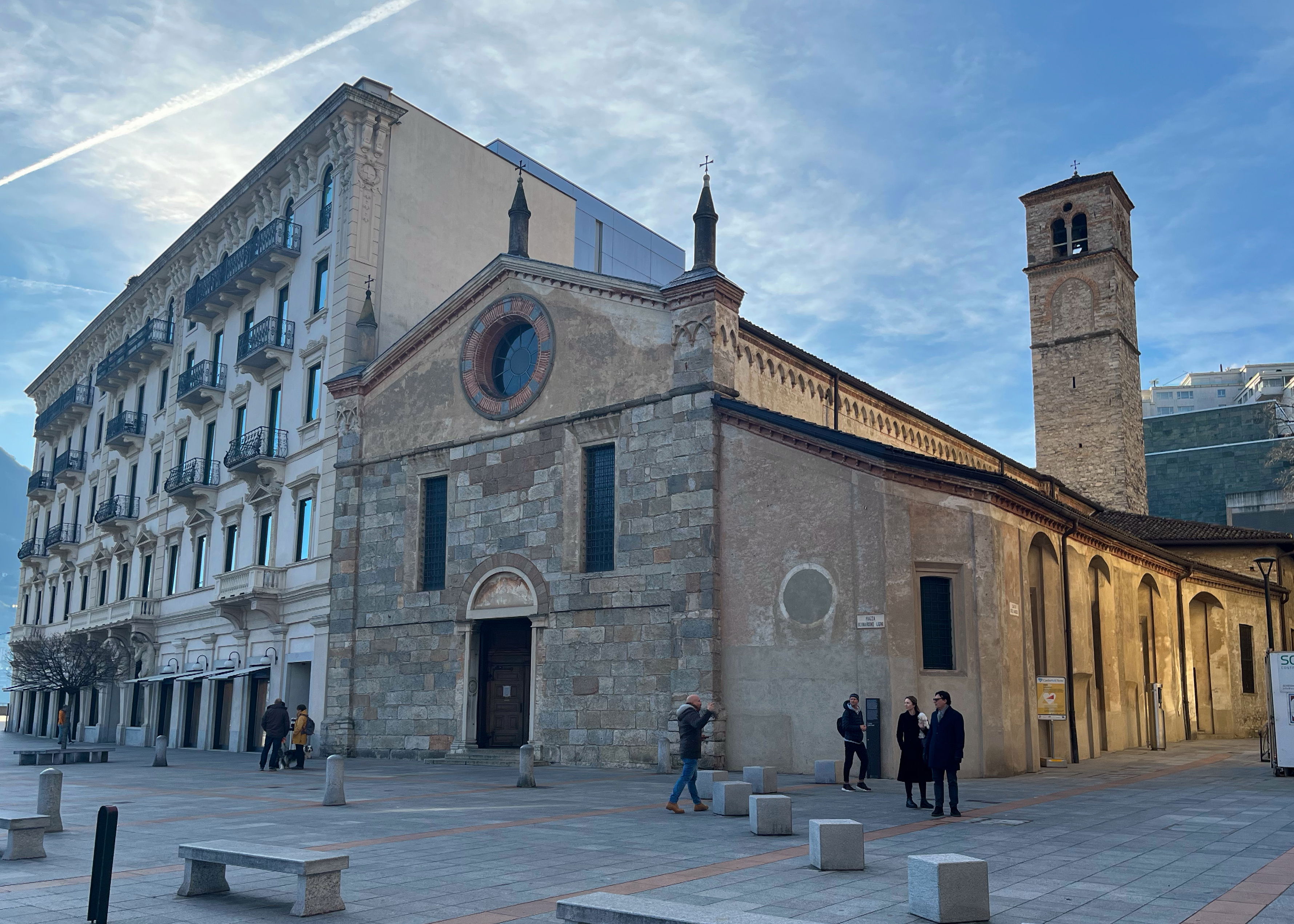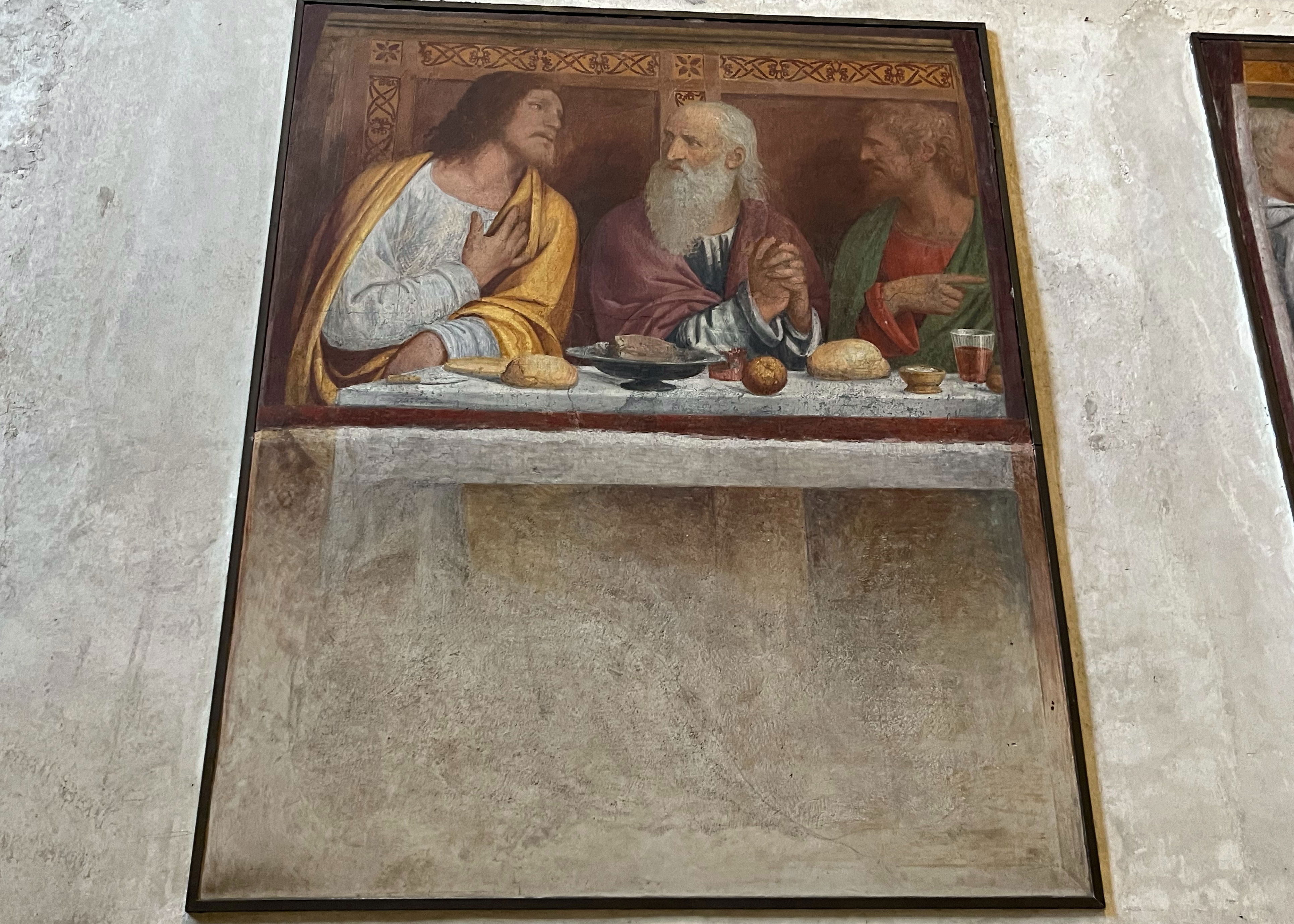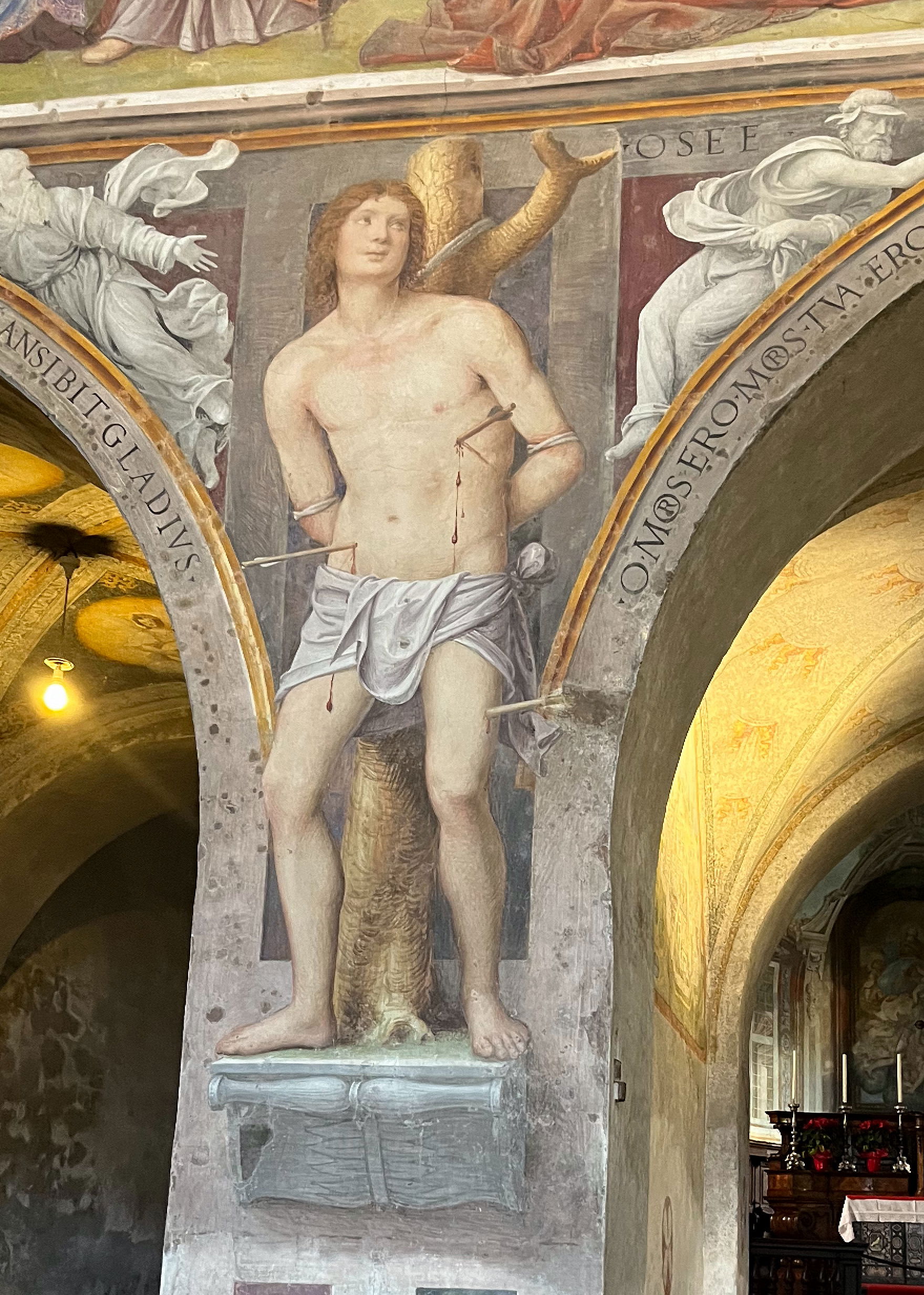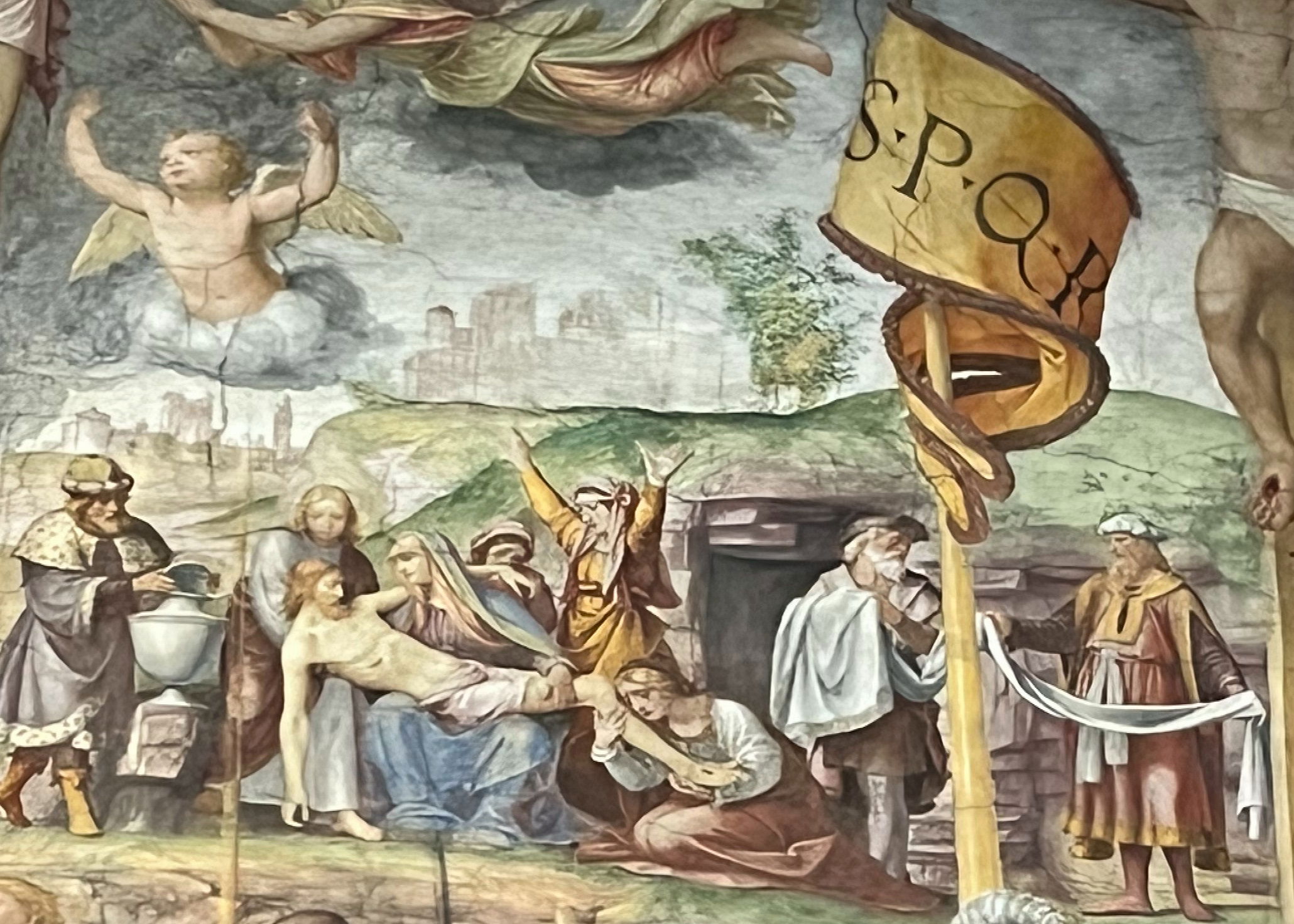Following Bernardo Luini to Lugano
After completing his work at San Maurizio in Milan , Luini apparently went to Lugano to the Church of Santa Maria degli Angeli. The church was built starting on 17 February 1499, near the southern entrance of what was then the village of Lugano. It was built on the initiative of the citizens of the village, in gratitude for two important events. In the first place, the church wanted to celebrate the renewed harmony among the citizens after the struggles between the Guelphs and Ghibellines,. Secondly, it was intended to thank the Observant Franciscans for their charitable work during the plague of 1498. The consecration of the church took place on 26 June 1515. In 1525 the construction of the adjacent Franciscan convent was completed which in 1848 was secularized and converted into a luxury hotel designed by Luigi Clerichetti. The construction of the hotel required the masonry of three windows on the left wall of the church, as well as the construction of the rose window that still stands on the façade today. There are three works by Luini inside.

Santa Maria degli Angeli, Lugano
Luini executed a Last Supper for the refractory of the monks. In Williamson’ view , it nearly matched Leonardo’s Cenacolo, he says of various representations of the Last Supper;
“Not one of them is so wonderful as that which remains at Sta. Maria della Grazie in wrecked condition, and the scene painted by Luini comes very close to it in beauty and in devotion."

Luini's "Last Supper "at Santa Maria degli Angeli
The fresco was originally divided by two columns into three parts, in the two side divisions are three apostles. Jesus and the remaining six apostles are all in the centre portion. Judas who is grasping the bag, and at whose feet rests a huge sleek cat, is seated outside the table, close against one of the columns, and another apostle occupies a similar position with regard to the other column. Putting Judas outside the table was originally adopted by Giotto at Santa Croce, but the attitude of Judas in the Luini picture is more like his attitude in Giotto’s Cenacolo in the Accademia in Florence, where Judas is seen looking up alarmed and rising in order to escape. In that picture St. Philip is pointing to him, and it might be St Philip whom Luini places looking at Judas in his pictures. Luini shows Judas with a pouch , possibly containing his thirty pieces of silver, which is clasped tightly in his hand, and he also represents the black cat, which is probably intended to typify Satan. Judas is looking away from Jesus and towards the viewers of the fresco, maybe there is something guilty looking about him as he faces the spectators. In modern film terms, he may be said to “breaking the fourth wall.”

Detail from the Last Supper .A grim and guilty looking Judas is looking straight at the audience, clutching his pouch of cash. The black cat looks rather more grey than black. St John on the ight is leaning on the shoulder of Jesus. Possibly its St Philip looking across the table at Judas. possibly St Peter is on the left. of Jesus
St John, overcome with amazement, appears, to be leaning on the shoulder of Jesus. This follows the text of Chapter 13 of the Gospel of John “There was at the table reclining in Jesus' bosom one of his disciples, whom Jesus loved.”
Apart from St Peter who was traditionally shown to the left of Jesus, the rest of the apostle are difficult to identify as individuals. Luini’s painting is different to Leonardo’s , who put all the Apostles on the one side of the table, with Judas quite close Jesus, intensifying the surprise of the other Apostles that one so intimate should be the traitor. According to Matthew 26; 23-25
“ and as they were eating he said. Verily I say unto you, that one of you shall betray me. And they were exceeding sorrowful , and began to say unto him every one, is it I , Lord?”


In Leonardo's picture many of the Apostles have risen from the table in their horror and surprise, but in Luini's only one is on his feet, and rising up at the end of the table. The others are all seated, one points to Judas the other two gaze at him with amazement ; one clasps his hands and is petrified with horror, one near to Jesus doubts whether he has heard correctly, and St. Thomas rebukes Jesus for his statement, which he cannot bring himself to believe.
The many differences between Leonardo’s Cenacolo and Luini’s work , suggest that Luini was not just an imitator of Leonardo, but an original artist with his own merits, influenced strongly by Leonardo but with his own style. As with other Luini works, there is a lot of tenderness and humanity in the picture. Several of the Apostles may be thinking more of their own faults and self-accusations than Judas. Those who look on Judas seem to be pitying him and contemptuous of his betrayal. Williamson reckoned the Last Supper to be;
“ probably the earliest of the three Lugano pictures, but as a rule it is neglected by visitors to the church by reason of the great Passion fresco nearby, which demands such overwhelming attention.”

Luini's "Passion " fresco. It was like a huge story board here the faithful could look at every scene as the priest read from the gospels,
And of course it is the passion fresco covering a whole wall, separating the nave from the choir, and extending right up to the ceiling, which ceases the visitor’s attention .Not surprisingly , it is like a huge story board mapping out the last days of Jesus. As a priest read out the gospels, the congregation could look at the images and see each scene the priest was talking about. Its base line is one drawn along the tops of the three circular headed archways in the wall giving access to the choir, the heads of these archways, the spaces in between each arch and the corners to each archway are also filled with decoration. Two giant figures of St. Sebastian and St Roch, situated on either side of the central archway, that appear to hold up. the Passion scene above them. As discussed, when looking at Luini’s fresco in Saronno, Saints Roch and Sebastian were invoked as protectors against the plague and Lugano had been hit by an outbreak between May and November 1498, which had killed more than two hundred people, so it is not surprising to see them here.

Lugano had been hit by plague in 1498. The citizens may have attributed survival to St Roch, whose rolled up trouser leg shows a plague buboes. In legend he survived the plague and helped cure other victims

St Sebastian whose survival from all those arrows inspired believers Although he was subsequently beheaded.
In the corners of the archways are figures of six prophets, Ezekiel, Simeon, Hosea, Jeremiah, David and Zechariah, being those who specially foretold the death of Christ Around the arches are inscriptions, and above rises the great Passion fresco. Zechariah had prophesised soldiers would pierce the Messiah's side, and Isaiah that the Messiah would be a sacrifice for sin. There is a lot going on , with several hundred figures, arranged more or less in two lines. In the centre is a gigantic cross, bearing upon it the body of Christ, and on either side are smaller crosses with the two thieves. At the extreme top of the pediment that encloses the fresco is a representation of God ; below that, is the Holy Spirit, and on either side of the two members of the Holy Trinity, and just above the great cross on which Jesus is dying are large angels, two of whom are leaning upon the arms of the cross and gazing with pitying eyes upon him. Around them is a group of smaller cherubs who surround the figure of Christ On the summit of the other two crosses appear two strange symbolic pairs of figures. A beautiful angel above the penitent thief is supposedly receiving his soul to carry it away to Paradise, the soul being represented as a lovely white miniature man, while opposite a black and repulsive figure of Satan claims the soul of the other thief, whom Luini has painted in similar form, but wholly black.

The stem of the central cross reaches right down through the picture, and rests on a little eminence at its very base, near to which are placed the skull and cross bones, and close beside the cross is seated a charming figure of a young man robed in blue, who looks out toward the spectator, and with one hand pointing upwards arrests attention and directs the spectator towards Jesus on the cross. Close around the foot of the cross, in a long line are crowded the dramatis persona of the tragedy. Mary Magdalene is richly attired and kneeling upon the ground with a deep look of sorrow. Her head is raised and her eyes are fixed on the cross ; her golden hair streams down her back, her arms are stretched out at full length downwards, and the hands ended, and in this one figure, of which the back and profile only are seen by the spectator, Luini touches a chord of dramatic power that nowhere else in his pictures does he even approach. Close by this kneeling figure is a very pathetic group. The Madonna is seen swooning away in an agony of sorrow and supported by the holy women. On the other side a noteworthy figure is that of the centurion, who is depicted riding on a great white horse and gazing on the scene with astonishment and wonder.
Nearby, the bearded individual in the yellow tunic represents Joseph of Arimathea, he is bearing a vessel of vinegar, into which a sponge has been dipped, the sponge can be seen on the long pole which Joseph is holding up to Jesus
“29 A jar of wine vinegar was there, so they soaked a sponge in it, put the sponge on a stalk of the hyssop plant, and lifted it to Jesus’ lips.
30 When he had received the drink, Jesus said, “It is finished.” With that, he bowed his head and gave up his spirit.”

At the base of the cross is the cross dignifying Golgotha. Mary Magdalene, with te long blond hair is looking up at Jesus and Joseph of Arithemea in the yellow cape , is holding up a pole with the sponge of vinegar attached
In the foreground are Roman soldiers, violently struggling to tear the coveted garment into pieces, as described at John 19: 23-24
“then the soldiers, when they had crucified Jesus, took His garments and made four parts, to each soldier a part, and also the tunic. Now the tunic was without the seam , woven from the top in one piece. They said therefore among themselves , “ Let us no tear it but cast lots for it , whose shall it be “ that the scripture might be fulfilled which says: ”They divided My garments among them, And for My clothing they cast lots”. Therefore the soldiers did these things. “

In the foreground , Roman Soldiers are struggling to divide the robe of Jesus between them
The whole fresco is full of action of men, women, children, soldiers, and horses. Some of the faces are beautifully painted ; almost every face, whether looking towards Jesus or engaged in their own concerns is carefully executed. On the left, amongst the figures on horseback, is one venerable man with a long white beard, who may be a self-portrait of Luini as also seen at Saronno. Some have said that the centurion's face is Luini's, which might be more credible since Luini was in his forties at the time , so perhaps the painting in Saronno is somebody else.
Above the large crowd, on a raised plateau, even more is going on. A line of smaller figures, equally crowded, is broken up into specific groups. The figures depict in succession, from right to left, the scenes that preceded the Crucifixion. There is first the crowning with thorns, which is more or less a copy of the much larger scene painted in the Sala di Santa Corona in the Ambrosiana ; then the procession to Calvary, with Jesus bearing the cross ; then comes the embalming and entombment of, and lastly the scene of St. Thomas's disbelief when the risen Jesus stands in the midst. In the background is a landscape with mountains and hills, which is probably a view of Lugano and of the church in which the fresco appears, (similar to Luini’s Presentation fresco at Saronno). Upon two of the hills, framed by the pillars and arches of the temple to the extreme right and left of the picture are two more scenes from the life of Christ On the right is the agony in the Garden of Gethsemane, where an angel appears bearing the cup of sorrow for Jesus , with the disciples lying fast asleep. In the opposite corner is represented the Ascension. Jesus is in the clouds surrounded by angels, and below is the angel of the Holy Spirit coming to comfort the throng of kneeling Apostles and companions.
One could spend hours looking at all the details and get quite a stiff neck in the process, Just to home in one detail , it is worth looking at the little scene of the entombment . The four canonical gospels, written between 66 and 95, conclude with an extended narrative of Jesus's arrest, trial, crucifixion, entombment, and resurrection. In the Gospel of Mark (the earliest written around the years 66 and 72) , Joseph of Arimathea is a member of the Sanhedrin, which had condemned Jesus, who wishes to ensure that the corpse is buried in accordance with Jewish Law, according to which dead bodies could not be left exposed overnight. He puts the body in a new shroud and lays it in a tomb carved into the rock.
43Joseph of Arimathea, an honourable counsellor, which also waited for the kingdom of God, came, and went in boldly unto Pilate, and craved the body of Jesus.
44And Pilate marvelled if he were already dead: and calling unto him the centurion, he asked him whether he had been any while dead.
45And when he knew it of the centurion, he gave the body to Joseph.
46And he bought fine linen, and took him down, and wrapped him in the linen, and laid him in a sepulchre which was hewn out of a rock, and rolled a stone unto the door of the sepulchre.
47And Mary Magdalene and Mary the mother of Joses beheld where he was laid.
In historical terms , an argument in favour of a decent burial before sunset is the Jewish custom, based on the Torah, that the body of an executed person should not remain on the tree where the corpse was hung for public display, but be buried before sunrise. The Jewish historian Josephus, writing later in the century, described how the Jews regarded this law as so important that even the bodies of crucified criminals would be taken down and buried before sunset. The Digesta, a Roman Law Code from the 6th century AD, contained material from the 2nd century AD stating that "the bodies of those who have been punished are only buried when this has been requested and permission granted." John 19:28-42 mentions the presence of Nicodemus , who bought with him a mixture of myrrh and aloes , about 75 pounds. Possibly he is the man carrying the large urn following the procession. Nicodemus is supposed to have been a pharisee, or “leader of the jews” and the man following, with his ermine robes and formidable headdress, looks like a leader. All four gospels mention women disciples being present at the entombment, the Gospel of St Mark mentions Mary the mother of Jesus, Mary Magdelene and also Mary of Cliopas and Mary Salome. It appears that Luini added Mary, the mother of Jesis as well. Possibly one of the men holding the linen is again Josph of Arimathea although looking different to the version below the cross .

Detail of the entombment of Jesus from high up on the fresco
Williamson regards the composition as being too crowded with figures and action. He says:
“It is lacking in distinctness, in definition, and in suitable composition. The crosses by reason of the two lines of figures are far too high, and could not be reached by the soldiers, even with the gigantic spear that one of them holds. The very tops of the two standards that wave in the breeze, and which are on enormous poles, do not reach the arms of the central cross. Even the air is so full of winged spirits that the dignity of the Crucified One is impaired, and the cross with its Divine Burden loses the prominence that should attach to it.”
The art historian , Bernard Berenson is even more critical, in the fee pages of the "The North Italian Painters" , in which he devotes, mainly to having a go at Luini, , he says
"Consider the vast anarchy of his word renowned Lugano ' Crucifixion ' ; every attempt at al expression ends in caricature"
Luini must have been trying to paint the scene as well as he could with considerable religious enthusiasm , may be by tying so hard and cramming so much detail into one fresco , he defeated his own objective and lost some of the spontaneity , warmth and movement in his characters. Nevertheless it is a remarkable piece of art.
For further reading